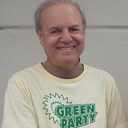Why the Green Party can’t (yet) be Deep Green, instead has gone Red
On Saturday Howie Hawkins was nominated to become the Green Party presidential candidate.
Three kinds of people come in to the Green Party:
* left-liberal environmentalists for whom the Democrats are not Bernie-type social democratic enough
* socialists who identify as ‘eco-socialists’ (“Red and Green”)
* Deep Greens, who are radically decentralist, communitarian, bioregionalist
It figures that the last category constitutes a minority. I belong to that category. What we advocate goes against the grain of the whole trajectory of modern civilization. Our ideology is off the commonly understood left-right spectrum. It represents a transition of thought, a radically different worldview, a major paradigm shift. To us, ‘unsustainable’ means unsustainable — which means pending breakdown and collapse — which means the task is to deconstruct the Leviathan [monster] of the industrial state in all its aspects . . . governmental, economic, cultural . . . and build the new society within the shell of the old. A Green world would be comprised of humanly-scaled bioregional communities living more simply and thus much more lightly on the earth. We understand that this vision currently resonates with a only small minority of the population — and even a minority of those who come in to the Green Party.
So the main contention in the Green Party for leadership and influence is between the left-liberal-reformist environmentalists and the socialists. Ralph Nader was a representative of the former and for years that type of Green was ascendant. But ever since the founding conference in 1984 the socialists have worked hard to become predominant. In recent years they’ve won out. The youth caucus, formerly called Youth Greens, was renamed ‘Young Ecosocialists’ about two years ago. And now the presidential candidate is an advocate of ecosocialism. He says his goal is to have the Green Party become a working class party and lead a unification of the socialist left.
I say they’ve turned the Green Party into a Red Party. But the ecosocialists disagree, they say their ideology is a melding of Red and Green. I believe you can distinguish a movement by its literature. Included in a Red/workerist bibliography you’d be likely to find (in roughly chronological order): Marx, Engels, Bakunin, Lenin, Trotsky, August Bebel, Karl Kautsky, Eduard Bernstein, Eugene Debs, Rosa Luxemburg, John Reed, Emma Goldman, Antonio Gramsci, George Lukács, Norman Thomas, Herbert Marcuse, Louis Althusser, Mao Zedong, Max Schachtman, Paul Sweezy, Isaac Deutscher, Frantz Fanon, Hal Draper, Erich Fromm, C. Wright Mills, E. P. Thompson, Michael Harrington, Howard Zinn, Stanley Aronowitz, Slavoj Žižek, Victor Wallis, John Bellamy Foster. That’s what my personal library looked like back when I was a student Marxist!
Those books are in boxes now in my attic. My own “Red to Green” transition started during the eighties, and my bookshelves have since become populated with the essential works of the eco-communitarian Deep Green movement writers:
Nineteenth century: Henry David Thoreau, William Morris, Élisée Reclus, Edward Carpenter, Peter Kropotkin, John Muir.
Early- and mid-twentieth century: Ralph Borsodi, Murray Bookchin, Rachel Carson, Stanley Diamond, Paul Goodman, Ivan Illich, Leopold Kohr, Mildred Loomis, Aldo Leopold, Lewis Mumford.
1970s: Wendell Berry, Barry Commoner, Ernest Callenbach, Edward Goldsmith, Theodore Roszak, Marshall Sahlins, E. F. Schumacher, Gary Snyder.
1980s: Rudolf Bahro, Herman Daly, David Ehrenfeld, Chellis Glendinning, Petra Kelly, Ursula Le Guin, Carolyn Merchant, Stephanie Mills, Arne Næss, Fredy Perlman, Jonathan Porritt, Charlene Spretnak, Langdon Winner.
1990s: Gar Alperovitz, Andrew Dobson, Riane Eisler, Richard Heinberg, David Korten, Jerry Mander, Helena Norberg-Hodge, Daniel Quinn, John Rensenbrink, Wolfgang Sachs, Kirkpatrick Sale, Vandana Shiva, David Watson.
2000s: Samuel Alexander, John Clark, Charles Eisenstein, Rob Hopkins, Caroline Lucas, Michael Shuman, Ted Trainer.
Some ecosocialists have an idea that our movement can take the literature of the traditional left as a core and then simply expand the critique by grafting on ideas from some of the above ecology-oriented theorists. They assert that our movement should be a hybrid; we should identify as “watermelons” (green on the outside, red on the inside). But I’ve become convinced that we’re really dealing with two profoundly different worldviews.
Most of the left still skews toward the Red. For example, the ‘Resources’ page of the website of the Green Eco-Socialist Network references Jacobin Magazine but not Green Horizon Magazine. Nonetheless . . . Deep Greens shouldn’t despair. Rather, I think we should appreciate how far things have come, how much we’ve already influenced the left. We should recognize that there is an unfolding process going on. During the transition, for better or worse, the “watermelon” idea will figure to have some appeal. Deep Green is the future, but it will take time to get there.
Meanwhile, my library is open for borrowing. Start with Thoreau.
